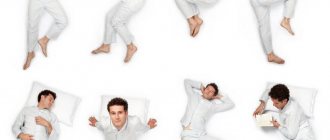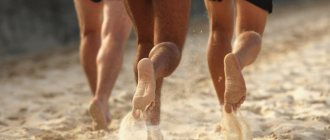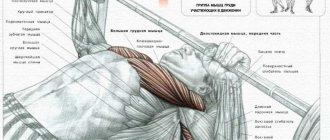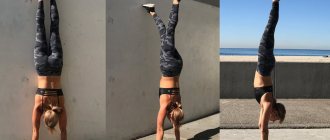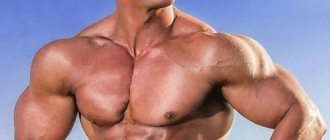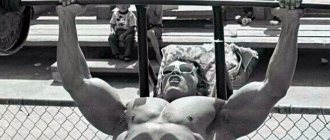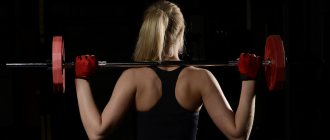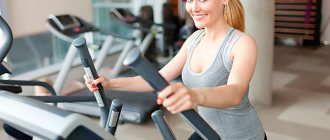Working out the trapezius muscle is very important both for appearance and for developing strength and protecting joints from injury. Basic back training does not load the trapezius enough; additional isolated exercises are required to pump it up. Let's look at how to pump up the trapezius, basic exercises and training principles that allow you to achieve a rapid increase in the volume and strength of this muscle.
A well-developed trapeze gives a powerful look and completeness to the upper torso. But this only applies to the male figure. A pumped-up trapezius does not decorate girls and women; they may need to pump up the trapezius muscle only in preparation for serious bodybuilding competitions.
Functions of a trapezoid
The trapezius muscle diverges symmetrically on both sides of the upper part of the spinal column, attaching at the top to the cervical vertebrae and occipital bone. The muscle fibers of the middle part of the trapezius are attached to the outer edges of the collarbones and scapular bones, and the fibers of the lower part are attached to the shoulder blades.
Since different parts of this large superficial muscle are attached to different bones, then, accordingly, the function of the trapezius muscle is determined by the totality of the functions of each of its parts. The upper part of the trapezius is responsible for raising the shoulder girdle upward and is involved in raising the arms. The lower trapezius muscle is responsible for lowering the shoulder girdle and is involved in lowering the arms. And the middle zone of the trapezius ensures the reduction of the shoulder blades.
What are trapezoids responsible for?
The trapezius muscles ensure the maintenance of posture and the correct position of the shoulder girdle. They raise their shoulders at the right moment. To help you understand what these muscles are needed for, imagine how you shrug your shoulders. We perform this “ritual” when we don’t know the answer to a question asked, or we simply don’t care about it.
So, the function of the trapezius is to raise the shoulders. In addition, these muscles work when we raise our arms up and to the side. If a person’s trapezius muscles are removed, his arms will hang lifelessly, supported only by the ligaments of the shoulder.
Now let's move on to how to make big traps in the gym or at home. No matter where you work out, you will need a barbell and dumbbells. All exercises can be done standing.
Features of training
Since the functions of different parts of the trapezius muscle are different, different exercises are needed to train each of them. The middle and lower trapezius area is well worked out when pumping up the back muscles - any type of bent-over rows, shoulder presses (lifting weights overhead).
But the upper part of the trapezius is not worked enough during basic back training. Therefore, there are special types of exercises for it - shrugs. These are exercises for raising the shoulders with weights in the lowered arms.
Targeted pumping of the trapezius is carried out on back training days, after performing basic exercises. It is enough to perform 2-3 exercises in 4-5 approaches with minute pauses. To avoid addiction, exercises should be changed. As strength increases, working weights must be increased, maintaining the number of repetitions until muscle failure in the range of 7-10 times.
Recommendations and tips
Basic recommendations to help improve movement efficiency and avoid injury:
- It is important to remember that shrugs are a movement in which weight does not play a major role. It is much more effective to do the exercise correctly with a light weight than to load it more and distort the technique;
- You should not do a “pigeon nod,” when the athlete tilts his neck forward with each lift of his shoulders. This will not only reduce the overall benefit, but is almost guaranteed to lead to problems in the cervical spine in the future;
- Perform the exercise at a moderate or slow pace. With fast shrugs, the target muscle will not always be fully activated;
- The key is to feel the area you are working on. This significantly increases the benefit even when working with light weights;
- When performing the exercise, your arms should be relaxed; you should “pull” the weight up by lifting your shoulders, not your limbs.
How to perform shrugs correctly
Shoulder raises with weights in your hands (shrugs) allow you to build a strong, voluminous trapezius only if you do them correctly. Therefore, before starting training, you should familiarize yourself with the advice of leading sports physiologists.
Dumbbells instead of barbells
Shrugs with dumbbells pump up the trapezius much more effectively than shrugs with a barbell, so they should be preferred. This is due to the fact that when performing shrugs with a barbell, the position of the hands is limited - they are in front of the hips, into which the bar rests, and it is impossible to move them even a little back. Because of this, shrugs with a barbell are performed strictly in a vertical plane - the shoulders move up and down.
But in addition to raising the shoulders up, the trapezius also performs the function of bringing the shoulder blades together, which requires movement in the horizontal plane. And in order to pump up the trapezius well, you need to use this movement too. This becomes possible only if you take dumbbells instead of a barbell to perform a shrug.
Execution technique
Performing shrugs with dumbbells that hang freely in the hands at the sides of the body does not limit the necessary movements of the shoulders for effective pumping of the trapezius. Here are the main points of the rules for performing shrugs:
- Before starting the exercise, the muscles must be well warmed up.
- You can pump up the trapezius only with low-repetition training; the weight of the dumbbells should be selected so that muscle failure occurs at 7-10 repetitions.
- Straighten your back, keep your head straight, straighten your legs shoulder-width apart, hold dumbbells in your arms at the sides of your hips.
- As you inhale, squeeze your shoulder blades together, and then, without spreading them apart (this is important), slowly pull your shoulders towards your ears to the maximum possible height. The head must be kept straight, the chin must not be brought closer to the chest to avoid injury to the cervical vertebrae.
- Hold for a couple of seconds at the top.
- As you exhale, lower and relax your shoulders.
- Perform shrugs in 4 sets with pauses of 45-60 minutes.
It may happen that the available maximum weight of dumbbells is not enough for low-repetition training. In this case, trapezius training can be performed with a barbell, but bending forward to make it possible to retract the shoulder blades is strictly prohibited. This can lead to lower back injury. With a barbell, as with dumbbells, shrugs should be performed while strictly keeping your body straight, with your back straight.
Shrugs are also good because this element can be introduced into the technique of already familiar basic back exercises, making them even more effective. Let's look at this using the example of bent-over dumbbell rows.
general information
It doesn't matter whether you're training for bulk or for definition, it has virtually no effect on your technique. But the amount and schedule of your workouts affect the speed at which you achieve the desired result overall.
To achieve the desired results as quickly as possible, you need to give your body time to recover. You should not train the same muscle group two days in a row. After training a muscle group to failure, you will need adequate recovery time. Working your trapezius (or your entire back) one day and returning to the same group two days later will not achieve the desired results.
The trapezius muscles will not have time to recover, and this is necessary for a full workout. If your goal is to gain mass and your muscles are in the process of recovery, subsequent back training may only lead to injury.
With all this in mind, it is best to work on this group once a week. And after a powerful trapeze workout like this, you need to get plenty of rest and recovery. In addition, the load on the trapezius will be present when training the back and shoulders, so it will not go completely unnoticed. Sufficient rest time is a guarantee for the best results.
The number of repetitions and approaches will differ when training for relief and for mass gain. When bulking, you'll be using the highest possible weights, which means you'll be able to perform one to four reps before muscle failure.
The number of approaches required when gaining weight is on average 3-5.
These exercises will explode your muscles if you do them with as much weight as possible. They allow you to gradually increase the weight for subsequent sets until you can only perform one repetition.
When working on terrain, you need to use heavy weights with a high number of repetitions. Increasing the number of repetitions is important for breaking down muscle fibers, which in turn leads to more growth.
Therefore, it is also necessary to perform 3-5 approaches, but instead of 1-4 repetitions, as when working on mass gain, you need to do 8-12. Never stop at 12 reps if you can do more. Continue the exercise until failure. Let 8-12 reps be your guideline, but don't limit yourself to them. If you're doing more than 8-12 reps, that means it's time to increase the weight. Don't save energy for the next approaches.
The only possible way to improve relief and strength is to work the muscles to failure.
Bent-over dumbbell row shrugs
Bent-over dumbbell rows work all the back muscles, as well as the rear deltoids. By introducing shrugs into this basic exercise, we get, in addition to everything, an increased emphasis on pumping up the trapezius. The classic dumbbell row technique is well known to everyone:
- Place one arm and leg on the support, giving your body an inclined position. Bend at the waist; under no circumstances should you round your back.
- Take a dumbbell in your free hand. Next, you should row the dumbbell upward by bending your elbow. The distribution of the load on the muscles will depend on the position of the elbow in relation to the body and on its trajectory upward, so perform the version of this exercise that suits your tasks.
- However, do not forget that we decided to complicate this exercise by introducing an element such as shrugs. This is done like this: before you start the dumbbell row, pull your shoulder as high as possible and only after that do the row, maintaining this shoulder position throughout the entire movement cycle.
- Only after lowering the dumbbell down, lower your shoulder and relax.
You will feel how much more efficiently the trapezius is loaded when performing this type of deadlift. This version of the dumbbell row allows you to work out the muscles involved in this exercise, and as a bonus, pump up the trapezius muscle to the desired volume.
About enhanced targeting training
If training is carried out correctly, the trapezius grows quickly. She responds gratefully to power loads, easily increasing in volume.
Having noticed such rapid progress, beginners often begin to train these muscles even more intensely. According to the principle - we swing the trapezes, and then whatever happens.
As a result, after a fairly short period of time (6-12 months), the figure of such athletes takes on a caricatured appearance. Powerful trapezius with weak deltoid muscles visually narrows the shoulders and makes them sloping.
Look at the figures of professional bodybuilders. Yes, their trapezes are huge. But the shoulders are not inferior to them in size. Only with the help of even larger deltas can you create a harmonious upper shoulder girdle.
To avoid pronounced muscle imbalance, which is common among beginners and intermediate levels, the training load on the trapezius should be minimal. For the first 6-12 months of training, they do not need to be trained specifically.
As a rule, at the initial stage, for them, an indirect load when performing the same deadlifts or barbell rows to the chin is quite enough.
To be convinced of this, just look at this part of the body of “strongmen” (powerlifters, weightlifters and strongmen). They do a lot of deadlifts in their workouts and practically do not train the trapezius with special exercises such as shrugs.
For beginner and intermediate levels of physical fitness, it is recommended to focus on training the deltoid muscles.
You should move on to targeted training only after you have achieved good deltoid volume in order to eliminate any possible imbalance.
To do this, a mini-complex consisting of two exercises is enough - one for the upper part, the other for the lower part. In this case, the best exercise for the trapezius is shrugs, which are performed with a barbell or dumbbells while standing and bringing the shoulder blades together while lying on your stomach on an inclined bench with dumbbells.
For good results, one targeted workout per week is enough. After all, as you remember, this muscle group receives a lot of indirect load in other exercises.
Perform 3-4 working sets of each exercise, 15-20 repetitions, with medium or heavy weights.
Dumbbell press while lying on your stomach
Despite the fact that the dumbbell belly press is performed with light dumbbells, it allows you to perfectly pump the trapezius, especially its lower part. The order of its execution is as follows:
- Take a pair of dumbbells weighing 1-2 kg.
- Lie face down on the floor, do not arch your back, legs straight.
- Bring your hands with dumbbells to your shoulders without touching the floor.
- Do overhead dumbbell presses by extending your arms horizontally forward and back to your shoulders, while keeping them constantly suspended.
This exercise will check the condition of your trapezius. If you have underused it in training, this press will be very difficult to perform, and the next day you may feel severe pain in the trapezius muscle. But by including this bench press in your training program, you can gradually improve the situation.
Anatomical characteristics
The trapezius muscle has the shape of a triangle, stretching along the vertebrae to the neck and shoulder.
This is a fairly large muscle, so it is divided into three sections according to location.
These include:
- upper section - located along the cervical spine;
- middle - located between the shoulder blades;
- lower - in the area under the shoulder blades.
The trapezius has the most tendons; according to this indicator, it is the record holder among the muscles of our body.
Tendon bundles are short in length, have a complex arrangement and stretch from:
- protrusion of the back of the head;
- medial third of the superior nuchal line of the occipital bone;
- nuchal ligament;
- spinous processes of the seventh cervical vertebra;
- supraspinous ligament.
All ligaments converge at the junction of the humerus and scapula. Most often, it is the upper part of the trapezoid that is subject to pumping.
This muscle is innervated by the processes of the accessory section and the cervical plexus (third-fourth pair).
The trapezius muscle is multifunctional.
It does the following:
- Brings the scapula and spine closer together.
- Raises, lowers and rotates the scapula by contracting various fascicles.
- Extends the neck, participates in tilting the head back.
- Turns the head during unilateral contraction.
The complex structure determines the many functions it performs.
And in anatomy there is such a law: the more complex the system, the more unstable and fragile it is. This must be taken into account during training to avoid injury.
Bodyweight exercises
Workout enthusiasts can pump up their trapezius using their own body weight. Let's look at how to do this on the horizontal bar, on uneven bars, and also in the absence of these apparatuses.
Horizontal bar
To pump up your trapezoid on the horizontal bar, you need to be able to do pull-ups. Upside down pull-ups are especially effective for training the trapezius muscle. They are performed like this:
- Assume a hanging position on the bar.
- Give your body a horizontal position by raising your bent legs up.
- Do pull-ups in this position, while squeezing your shoulder blades and straining your back.
If you can’t do pull-ups on the horizontal bar upside down yet, you can do them on the uneven bars. This can be easily done by hanging and at the same time placing your feet on the bars so that your body is parallel to the floor. The main thing is not to forget to squeeze your shoulder blades together and tense your trapezius muscle when doing pull-ups.
Bars
You can pump up your trapezoid with a simple exercise on the uneven bars. To do this you need:
- on the uneven bars, go point-blank with straight arms;
- from this position, stretch your neck up with all your might, while straining your back muscles, bringing your shoulder blades together, sticking out your chest and arching your lower back;
- Having fixed in this position for a couple of seconds, relax your shoulders and “immerse” your neck in them;
- repeat stretching the neck with tension in the back muscles and subsequent relaxation until muscle failure occurs.
Do not forget that throughout the entire exercise you need to maintain the position of emphasis on straight arms.
Handstand
You can pump up the trapezoid without any equipment, and the effect of the exercise will be no worse than when using dumbbells and barbells. With this exercise you can pump up your trapezius at home. True, it’s not easy to do:
- do a straight arm stand with your feet leaning against the wall;
- stretch your whole body upward, straining your trapezius and squeezing your shoulder blades together;
- Having fixed yourself in the extreme position for a couple of seconds, relax your shoulders and lower your body down vertically without leaving the stance;
- repeat the exercise until the muscles are completely tired.
Having set yourself the goal of pumping up the trapezius, do not forget that attention must be paid to working out all muscle groups. Only under this condition can you get a harmoniously developed and strong body.
A little about anatomy and functions
The trapezius is a fairly large and strong muscle. It originates at the back of the neck and goes down to the middle of the back.
This is a paired muscle that is located on both sides of the spine. It got its name from the shape of the figure it resembles.
In bodybuilding, it is customary to divide it into the upper (neck) and lower, dorsal (area in the back) parts. They perform different functions - the upper part raises the shoulders up, and the lower part brings the shoulder blades together. Therefore, different movements are used to train each.
Seated dumbbell flyes
This is a variation of the standing bent over swing. And the target muscles here are the rear deltoids, but the trapezius is also included in the work.
Technique:
- Sit on the edge of the bench. Lie with your stomach on your thighs, lightly weighted dumbbells hanging freely in your hands. Bend your elbows slightly and spread them apart.
- Exhale and perform dumbbell raises through the sides without lifting the body. The position of the body cannot be changed.
- Inhale and slowly return to the starting position. Lowering the dumbbells is slower than swinging up.
It is recommended to perform the exercise 8-12 times in three to four sets with 1 minute rest between sets.
The lower trapezius is also engaged when lifting dumbbells overhead. Such presses are usually performed to train the shoulders.
How many exercises to do on the trapezius in one workout?
Since the trapezius muscles can rightly be called an addition to the back muscles and deltoid muscles, this means that they also need to be trained in an average manner. I thought about it and came up with another simple formula:
SKUT = (SKUD + SKUS)/4
Where,
SKUT – average number of exercises for trapezius;
ACS – average number of exercises for deltas;
SKUS is the average number of exercises for the back.[/sociallocker] A fair question: why then divide by 4 and not by 2?
The answer is no less obvious: well, the deltoid muscles are twice as large as the trapezius muscles, and the latissimus dorsi muscles are much larger in volume than the trapezius muscles.
I don’t know whether I need to tell you more or not. Okay, I’ll explain with an example , it won’t hurt me.
